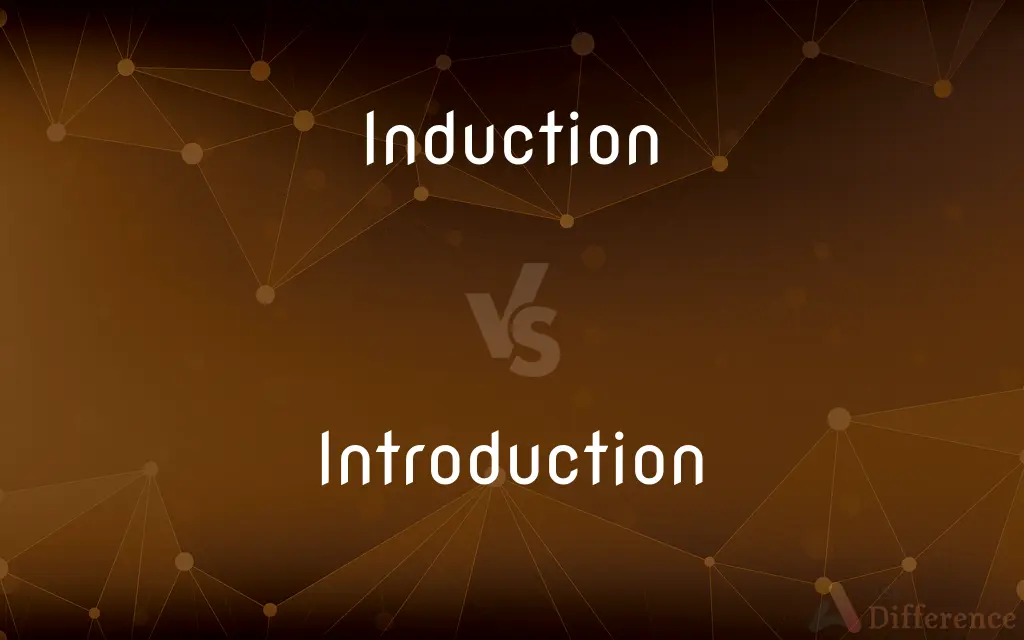Induction vs. Introduction — What's the Difference?
By Tayyaba Rehman & Fiza Rafique — Updated on February 28, 2024
Induction is the process of formally admitting someone to a position or organization, while introduction refers to the act of making something or someone known or presenting something new.

Difference Between Induction and Introduction
Table of Contents
ADVERTISEMENT
Key Differences
Induction and introduction both involve initial phases of processes or relationships but serve different purposes. Introduction, on the other hand, is broader and can refer to the act of making someone or something known, presenting a new concept, or initiating a first encounter. It can occur in social settings, when introducing people to each other, or in academic and professional contexts, when introducing new ideas or products.
Induction is a formal process, often involving training or ceremonies, to integrate someone into a new role, position, or organization. It's about familiarizing new members with the culture, policies, and responsibilities of their new setting. For instance, a new employee undergoes an induction program to understand their job duties and the company's operations. An introduction sets the stage for what is to come, providing essential background information or a preliminary overview.
Induction is specific to the context of integrating individuals into new roles or groups with a structured process, introduction spans various contexts from social to informational. For example, introducing a new topic in a lecture prepares students for the material they will learn, without the formalized integration process of induction.
The goals of induction and introduction also differ; induction aims to equip new members with the necessary tools, knowledge, and connections to succeed in a specific environment. Introduction, however, aims to inform, familiarize, or acquaint individuals with new information, people, or environments without the implication of a formal ongoing relationship or role.
Induction often requires active participation and engagement from the new member and the organization, involving specific activities designed to integrate and acculturate the individual. Introduction, in contrast, can be a one-sided act, such as when a speaker is introduced to an audience, requiring less engagement from the person being introduced.
ADVERTISEMENT
Comparison Chart
Definition
The process of formally admitting someone into a position or organization, often including training.
The act of making something or someone known, or presenting something for the first time.
Purpose
To integrate and familiarize new members with their roles, responsibilities, and the organization's culture.
To inform, acquaint, or present new ideas, people, or products to others.
Context
Typically used in employment, organizational memberships, and formal roles.
Can be used in a wide range of contexts, including social, academic, and professional settings.
Process
Structured, often involving a series of steps or events like training sessions.
Can be informal or formal, ranging from a brief mention to a detailed presentation.
Engagement
Requires active participation from both the new member and the organization.
May not require active engagement from the audience or the person being introduced.
Compare with Definitions
Induction
The generation of an electric current by a changing magnetic field.
Induction cooking heats pots and pans directly through magnetic induction.
Introduction
Making known by formal announcement.
The introduction of the guest speaker was met with applause.
Induction
Initiation into a new role with specific rituals or training.
Her induction into the honor society was celebrated with a special ceremony.
Introduction
The act of presenting a person to another person.
He made a formal introduction of his colleague to the client.
Induction
The formal process of integrating a new employee into a company.
The induction program includes a tour of the office and meetings with key team members.
Introduction
Bringing something new to the public.
The introduction of the new product line was a success.
Induction
A method of reasoning from specific cases to general rules.
The scientist used induction to formulate the new theory.
Introduction
The act of starting something for the first time.
Her introduction to skiing was an exhilarating experience.
Induction
The act of bringing about or giving rise to.
The medication aids in the induction of sleep.
Introduction
The initial section of a book or speech that outlines the purpose.
The book’s introduction provides an overview of the historical context.
Induction
A ceremony or formal act by which a person is inducted, as into office or military service.
Introduction
The action of introducing something
The introduction of muskrats into central Europe
Issues arising from the introduction of new technology
Induction
The generation of electromotive force in a closed circuit by a varying magnetic flux through the circuit.
Introduction
A formal presentation of one person to another, in which each is told the other's name
He returned to his desk, leaving Michael to make the introductions
A letter of introduction
Induction
The charging of an isolated conducting object by momentarily grounding it while a charged body is nearby.
Introduction
A thing preliminary to something else, especially an explanatory section at the beginning of a book, report, or speech
Your talk will need an introduction which states clearly what you are talking about and why
Induction
A formal ceremony in which a person is appointed to an office or into military service.
Introduction
The act or process of introducing or the state of being introduced.
Introduction
A basic or elementary instructional text
Common Curiosities
What is the key difference between induction and introduction?
Induction is a formal process of integrating someone into a new role or organization, while introduction is about making someone or something known.
Can introduction be part of an induction process?
Yes, an introduction can be a component of induction, such as introducing new employees to their colleagues.
Is induction only related to employment?
While commonly associated with employment, induction can also apply to memberships in organizations, societies, or clubs.
How important is an introduction in a presentation?
Very important; it sets the tone, provides background information, and prepares the audience for what’s to come.
Can induction involve training?
Yes, induction often includes training specific to the new role or organization.
Can an introduction affect the audience’s interest?
Yes, a compelling introduction can capture and retain the audience's interest, setting the stage for the content that follows.
Is an introduction necessary when launching a new product?
Yes, introducing a new product is crucial for informing potential customers and generating interest.
How long does an induction process typically last?
The duration can vary widely, from a single day to several weeks, depending on the organization and the role.
How can one make an effective introduction?
By being concise, relevant, engaging, and providing necessary background information.
Can the term induction be used in a scientific context?
Yes, in science, induction refers to reasoning from specific cases to general principles or the phenomenon of generating an electric current by a changing magnetic field.
Why is induction important for new employees?
It helps new employees understand their roles, the company culture, and builds a foundation for their success and integration into the team.
What are the benefits of a well-conducted induction program?
It can increase employee retention, improve job satisfaction, and accelerate the productivity of new hires.
What makes a good introduction?
A good introduction is clear, concise, and provides essential information to acquaint the audience with the subject.
What role does introduction play in academic writing?
It outlines the thesis, scope, and direction of the paper, engaging and guiding the reader.
Is it possible to have an induction without an introduction?
Practically, no, because induction processes typically start with introductory activities to orient the new member.
Share Your Discovery

Previous Comparison
Deep vs. Shallow
Next Comparison
Hackle vs. HeckleAuthor Spotlight
Written by
Tayyaba RehmanTayyaba Rehman is a distinguished writer, currently serving as a primary contributor to askdifference.com. As a researcher in semantics and etymology, Tayyaba's passion for the complexity of languages and their distinctions has found a perfect home on the platform. Tayyaba delves into the intricacies of language, distinguishing between commonly confused words and phrases, thereby providing clarity for readers worldwide.
Co-written by
Fiza RafiqueFiza Rafique is a skilled content writer at AskDifference.com, where she meticulously refines and enhances written pieces. Drawing from her vast editorial expertise, Fiza ensures clarity, accuracy, and precision in every article. Passionate about language, she continually seeks to elevate the quality of content for readers worldwide.
















































